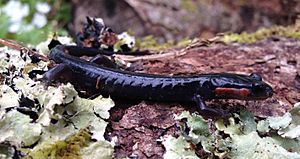Red-cheeked salamander facts for kids
Quick facts for kids Red-cheeked salamander |
|
|---|---|
 |
|
| Conservation status | |
| Scientific classification |
The red-cheeked salamander is a cool creature that lives in the Appalachian Mountains in the eastern United States. It's also known as Jordan's salamander or the Appalachian woodland salamander. This salamander is special because it's endemic to this area, meaning it's found nowhere else in the world! It belongs to a family called Plethodontidae, which means it breathes through its skin and the lining of its mouth, not with lungs!
Contents
What They Look Like
The red-cheeked salamander is usually a shiny, dark grey color. Its most noticeable feature is the bright red, orange, or yellow patches on the sides of its head, which look like rosy cheeks!
There's another salamander called the imitator salamander that looks very similar. It's thought to mimic (copy) the red-cheeked salamander. You can tell them apart because the imitator salamander has a faint line connecting its jaw to its eye and stronger back legs.
Where They Live
You can find the red-cheeked salamander in the mountains of the southeastern United States. Most of them live along the border between North Carolina and Tennessee. There's also a separate group in Rabun County, Georgia.
These salamanders live at high elevations, from about 210 to 1950 meters (700 to 6400 feet) above sea level. Many of them live inside the Great Smoky Mountains National Park. They prefer to live on land in forests, especially where there are red spruce and Fraser fir trees. They love areas with lots of moss, fallen leaves, and big rocks on the ground.
How They Live
Red-cheeked salamanders are shy creatures. During the day, they hide under rocks or inside and under rotting logs. They have shallow burrows (tunnels) they use to move around underground. When it rains or at night, they come out to look for food.
Each salamander has a small area it calls home. For males, this area is about 11 square meters (118 square feet), and for females, it's about 2.8 square meters (30 square feet). If they get moved far away, like 300 meters (about 984 feet) or more, many of them can find their way back home!
What They Eat
The red-cheeked salamander eats small bugs and other tiny creatures. Their diet includes worms, snails, springtails (tiny insects), spiders, and different kinds of insects and their larvae (young forms).
How They Protect Themselves
Many animals like birds, the common garter snake, the blackbelly salamander, and the spring salamander try to eat red-cheeked salamanders. But these salamanders have some cool ways to defend themselves!
When attacked, they turn their tail towards the predator and release a sticky, bad-tasting slime. They might even bite a snake's head or wrap their tail around it. Another clever trick is to drop their tail! This is called autotomy. The tail keeps wiggling, distracting the predator, while the salamander quickly runs away. Don't worry, their tail can grow back!
Life Cycle
Scientists don't know a lot about how red-cheeked salamanders have babies. But they think it's similar to other salamanders in their group, Plethodon. The female probably lays a group of eggs and then stays with them to protect them. Each egg then hatches directly into a tiny salamander, looking like a miniature adult, without going through a tadpole-like stage.
Their Status
The red-cheeked salamander is listed as "Near Threatened" on the IUCN Red List of Threatened Species. This means they are not in immediate danger, but their numbers could become a problem in the future.
Their population seems to be stable, but they only live in a small area, less than 5000 square kilometers (about 1930 square miles). The good news is they are common in many places, can handle some forest changes, and live entirely within a national park, which helps protect them.
The main things that could threaten them are acid rain, climate change (changes in weather patterns), and damage to the forests caused by a tiny insect called the balsam woolly adelgid.
See also
 In Spanish: Plethodon jordani para niños
In Spanish: Plethodon jordani para niños



